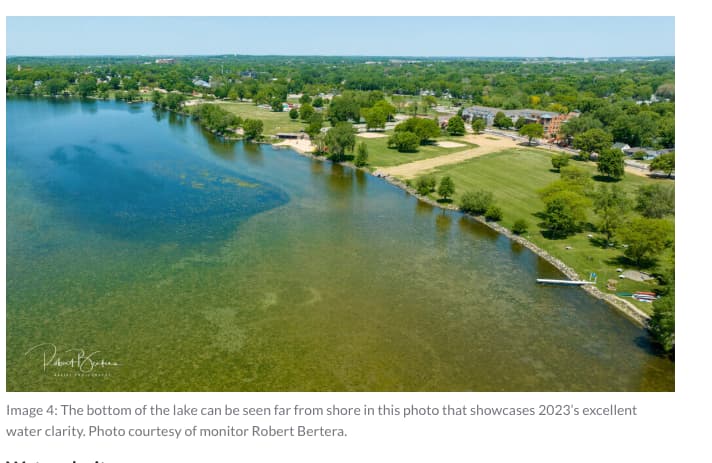BEDEMIR: What also floats in water?
VILLAGER #1: Bread!
VILLAGER #2: Apples!
VILLAGER #3: Very small rocks!
VILLAGER #1: Cider!
VILLAGER #2: Great gravy!
VILLAGER #1: Cherries!
VILLAGER #2: Mud!
VILLAGER #3: Churches – churches!
VILLAGER #2: Lead – lead!
ARTHUR: A duck.
CROWD: Oooh.
BEDEMIR: Exactly!
BEDEMIR: Who are you, who are so wise in the way of science?
ARTHUR: I am Arthur, King of the Britons
From “Monty Python and the Holy Grail”, written by John Cleese, Terry Gilliam, Graham Chapman, Eric Idle, Terry Jones and Michael Palin, 1973

(Graham Chapman as Arthur and Terry Jones as Bedemir discussing science, in “Monty Python and the Holy Grail”, 1975)
THE DATA
From 2014 to 2023, the average June to August clarity of Lake Kegonsa in Wisconsin increased by 60%**, from 60 centimeters to 96 centimeters.
From 2014 to 2023, the average June to August clarity of Lake Waubesa in Wisconsin increased by 35.5%, from 76 centimeters to 103 centimeters.
From 2014 to 2023, the average June to August clarity of Lake Monona in Wisconsin increased by 23%, from 87 centimeters to 107 centimeters.
From 2014 to 2023, the average June to August clarity of Lake Wingra in Wisconsin increased by 20%, from 100 centimeters to 120 centimeters, the highest clarity level possible.
From 2014 to 2023, the average June to August clarity of Lake Kegonsa in Wisconsin increased by an annual average of 6.7%.
From 2014 to 2023, the average June to August clarity of Lake Waubesa in Wisconsin increased by an annual average of 3.9%.
From 2014 to 2023, the average June to August clarity of Lake Monona in Wisconsin increased by an annual average of 2.6%.
From 2014 to 2023, the average June to August clarity of Lake Wingra in Wisconsin increased by an annual average of 2.2%.
From 2014 to 2023, the average June to August clarity of Lake Mendota in Wisconsin decreased by 8%, from 87 centimeters to 86 centimeters.
From 2014 to 2023, the average June to August clarity of Lake Mendota in Wisconsin decreased by an annual average of .9%.
From 2020 to 2021, the average clarity of Lakes Mendota, Monona, Waubesa, Wingra and Kegonsa in Wisconsin decreased by 1.1%, from 87 centimeters to 86 centimeters.
From 2020 to 2023, the average clarity of Lakes Mendota, Monona, Waubesa, Wingra and Kegonsa in Wisconsin increased by an annual average of 5.7%.
From 2022 to 2023, the 24% increase in the average June to August clarity of Lake Waubesa in Wisconsin was 515% greater, or over six times greater than its 3.9% long-term average annual increase in average June to August clarity from 2014 to 2023.
The clarity of Lake Waubesa in Wisconsin is increasing exponentially in clarity, going forward in time.
That’s because the health of the ether is inexorably increasing, and water clarity varies directly with the health of the ether.
From 2021 to 2022, the average clarity of Lakes Mendota, Monona, Waubesa, Wingra and Kegonsa in Wisconsin increased by 10.5%, from 86 centimeters to 95 centimeters.
From 2022 to 2023, the 11.1% average increase in the June to August clarity of Lake Wingra in Wisconsin was 404% greater, or over five times greater than its 2.2% long-term average annual increase in average June to August clarity from 2014 to 2023.
The clarity of Lake Wingra in Wisconsin is increasing exponentially, going forward in time.
That’s because the health of the ether is inexorably increasing, and water clarity varies directly with the health of the ether.
From 2022 to 2023, the 2.4% average increase in the June to August clarity of Lake Mendota in Wisconsin was 366% greater or well more than four times greater than its .9% long-term average annual decrease in average June to August clarity from 2014 to 2023.
The clarity of Lake Mendota in Wisconsin is increasing exponentially, going forward in time.
That’s because the health of the ether is inexorably increasing, and water clarity varies directly with the health of the ether.
From 2022 to 2023, the 14.3% average increase in the June to August clarity of Lake Kegonsa in Wisconsin was 113% greater, or well more than double its 6.7% long-term average annual increase in average June to August clarity from 2014 to 2023.
The clarity of Lake Kegonsa in Wisconsin is increasing exponentially, going forward in time.
That’s because the health of the ether is inexorably increasing, and water clarity varies directly with the health of the ether.
From 2022 to 2023, the 3.9% average increase in the June to August clarity of Lake Monona in Wisconsin was 50% greater than its 2.6% long-term average annual increase in average June to August clarity from 2014 to 2023.
The clarity of Lake Monona in Wisconsin is increasing exponentially, going forward in time.
That’s because the health of the ether is inexorably increasing, and water clarity varies directly with the health of the ether.
From 2022 to 2023, the average June to August clarity of Lake Waubesa in Wisconsin increased by 24%, from 83 centimeters to 103 centimeters.
From 2020 to 2023, the average clarity of Lakes Mendota, Monona, Waubesa, Wingra and Kegonsa in Wisconsin increased by 17.2%, from 87 centimeters to 102 centimeters.
From 2022 to 2023, the average June to August clarity of Lake Kegonsa in Wisconsin increased by 14.3%, from 84 centimeters to 96 centimeters.
From 2022 to 2023, the average June to August clarity of Lake Wingra in Wisconsin increased by 11.1%, from 108 centimeters to 120 centimeters, the highest clarity level possible.
From 2022 to 2023, the average clarity of Lakes Mendota, Monona, Waubesa, Wingra and Kegonsa in Wisconsin increased by 7.4%, from 95 centimeters to 102 centimeters.
The uncredited Intelligence operative from the State propaganda organ known as clearlakealliance.org walked the highest water clarity in the history of the lakes back to merely “good”, and said that it had been caused by “low spring and summer rainfall volume and intensity”.
From 2022 to 2023, the average June to August clarity of Lake Monona in Wisconsin increased by 3.9%, from 103 centimeters to 107 centimeters.
From 2022 to 2023, the average June to August clarity of Lake Mendota in Wisconsin increased by 2.4%, 84 centimeters to 86 centimeters.
THE ARTICLES
On January 4, 2024, cleanlakesalliance.org published “2023 Water Quality Monitoring Results”.
Where, under the false guise of familiarity, the uncredited author from the Clean Lakes Alliance wrote the headline in a completely general way, so that you can’t tell what water was monitored, who was doing the monitoring, and what the results were.
That’s because, as a propagandist, they know that seventy percent of readers only read the headlines, and this hedging generality goes a long way toward blunting awareness of the scope of the sudden, exponential in water clarity which they are attempting to obfuscate.
For those unaware, anytime an author is uncredited, it is proof that said author is an Intelligence operative.
The uncredited Intelligence operative from the State propaganda organ known as cleanlakealliance.org goes on to say “During the 2023 monitoring season, low spring and summer rainfall volume and intensity coincided with good water clarity, resulting in higher green algae but fewer cyanobacteria blooms across the five lakes.”
Where the uncredited Intelligence operative from the State propaganda organ known as clearlakealliance.org walked the highest water clarity back to merely “good”, and said that it had been caused by “low spring and summer rainfall volume and intensity”.
The word “intensity” has three syllables, and has been tacked on the end to amaze the Punch and Judy crowd.
Here’s a picture from the Clean Lakes Alliance article of one of the lakes, where the water is the cleanest and clearest that it has ever been, in history:
(Unnamed one of Lakes Mendota, Monona, Waubesa, Wingra and Kegonsa in Wisconsin. The editor who put the article together for the Clean Lakes Alliance did what little they could to hedge by omitting the name, to make the subject that much less searchable. That’s an example of the propaganda technique known as “compartmentalization”.)
The actual data on water clarity is, in journalistic parlance, “buried” twelve paragraphs down in the article.
For grade school children studying the subject in the future, asking the average American in 2024 to read twelve paragraphs is like asking someone from 1947 to swim the English channel.
From 2020 to 2023, the average clarity of Lakes Mendota, Monona, Waubesa, Wingra and Kegonsa in Wisconsin increased by 17.2%, from 87 centimeters to 102 centimeters.
From 2020 to 2021, the average clarity of Lakes Mendota, Monona, Waubesa, Wingra and Kegonsa in Wisconsin decreased by 1.1%, from 87 centimeters to 86 centimeters.
From 2021 to 2022, the average clarity of Lakes Mendota, Monona, Waubesa, Wingra and Kegonsa in Wisconsin increased by 10.5%, from 86 centimeters to 95 centimeters.
From 2022 to 2023, the average clarity of Lakes Mendota, Monona, Waubesa, Wingra and Kegonsa in Wisconsin increased by 7.4%, from 95 centimeters to 102 centimeters.
The article goes on to say:
"Average nearshore clarity for 2023 was up for all lakes compared to last year’s averages. All lakes except for Mendota reported the highest clarity readings since LakeForecast monitoring started in 2014 (Figure 3). All five lakes fell within the “good” water clarity designation represented in Figure 4.
Nearshore water clarity from 2014 to 2023 is measured in centimeters using a turbidity tube. The maximum value for the turbidity tube is 120 centimeters, indicating the clearest waters. Lines for average clarity are overlaid in the three different classifications for turbidity: Good (80-120 cm), Fair (50-80 cm), and Murky (0-50 cm)."
If the water in the five lakes under discussion is the clearest it’s ever been in history, why is its water clarity designation merely “good”, versus excellent?
I have exposed the duplicity of the Clean Lakes Alliance by using what was known in the old days as “fact checking”.
Jeff Miller, Honolulu, HI, February 14, 2024
If you’d like to be added to this free mailing list, please send me a note at [email protected]
